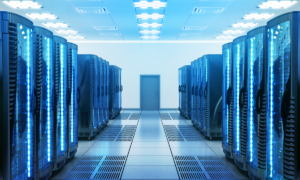The convergence of artificial intelligence (AI) and hyperscale data centers marks a transformative moment in technology. As AI workloads surge—driven by machine learning, generative models, and real-time analytics—hyperscale facilities are evolving to meet unprecedented demands for compute power, efficiency, and scalability. This white paper explores how AI is reshaping hyperscale data centers, the role of robotics and automation, and the implications for industries worldwide. With global data creation expected to exceed 180 zettabytes by 2025, the synergy between AI and hyperscales is not just exciting—it’s essential.
Introduction
The AI era is here. From autonomous vehicles to personalized healthcare, AI is redefining what’s possible, but its potential hinges on infrastructure capable of supporting it. Hyperscale data centers—massive, centralized facilities designed to handle vast computational loads—are the backbone of this revolution. Unlike traditional data centers, hyperscales are built for elasticity, housing tens of thousands of servers that can scale on demand. As AI applications grow more complex, these facilities are adapting with cutting-edge innovations, making them a focal point of technological progress.
The Rise of AI-Driven Hyperscales
Why AI Needs Hyperscales
AI workloads are uniquely demanding. Training a single large language model, for instance, can require millions of GPU hours, consuming terabytes of data and immense energy. Hyperscale data centers meet this challenge with:
- Massive Compute Power: Clusters of specialized hardware like GPUs and TPUs optimized for parallel processing.
- Scalability: Ability to add resources dynamically as AI models grow in size and complexity.
- Low Latency: Centralized infrastructure ensures rapid data access, critical for real-time AI applications.
Hyperscales Need AI, Too
The relationship is symbiotic. Hyperscales leverage AI to optimize their own operations:
- Energy Efficiency: AI algorithms manage cooling and power distribution, reducing costs in facilities that can use as much electricity as a small city.
- Predictive Maintenance: Machine learning predicts hardware failures, minimizing downtime.
- Resource Allocation: AI balances workloads across servers, maximizing utilization.
Robotics: The Game-Changer
Robotics is a linchpin in this evolution, bridging physical and digital advancements in hyperscales.
Automation in Action
- Hardware Management: Robotic arms handle server installations, upgrades, and replacements with precision, reducing human error.
- Monitoring: Drones and mobile robots scan racks, using sensors to track temperature, vibration, and wear—tasks too tedious or risky for humans at scale.
- Cabling: Automated systems organize and maintain the miles of cabling in hyperscale facilities, ensuring connectivity without bottlenecks.
AI-Powered Robotics
Robots aren’t just mechanical; they’re intelligent. Integrated AI enables:
- Autonomous Decision-Making: Robots prioritize tasks based on real-time data center needs.
- Continuous Learning: Machine learning refines robotic efficiency over time, adapting to new layouts or equipment.
Benefits
- Cost Reduction: Less reliance on human labor lowers operational expenses.
- Uptime: Faster repairs and proactive monitoring keep systems online.
- Sustainability: Optimized resource use aligns with green computing goals.
Key Trends and Innovations
- Edge-to-Hyperscale Integration
As IoT and 5G proliferate, edge computing handles local processing, but hyperscales remain the central hubs for training and large-scale inference, creating a hybrid ecosystem. - Liquid Cooling
AI’s heat-intensive workloads are pushing hyperscales toward liquid cooling solutions, which are more efficient than traditional air systems. - Modular Design
Hyperscales are adopting modular architectures, allowing rapid deployment of new capacity to keep pace with AI’s growth. - Carbon Neutrality
Companies like Google and Microsoft are pairing AI-driven efficiency with renewable energy, targeting net-zero emissions.
Challenges Ahead
- Energy Consumption: Hyperscales already account for ~2% of global electricity use, and AI’s appetite will drive this higher.
- Talent Gap: Designing and maintaining these systems requires specialized skills in AI, robotics, and data center engineering.
- Security: Centralized data hubs are prime targets for cyberattacks, necessitating advanced AI-driven defenses.
Implications for Industry
- Tech Giants: Hyperscales give companies like Amazon and Meta a competitive edge in AI innovation.
- Startups: Cloud-based hyperscale access democratizes AI development, leveling the playing field.
- Society: From smarter cities to advanced healthcare, AI-powered hyperscales will touch every sector.
Conclusion
The AI era and hyperscale data centers are intertwined, each fueling the other’s growth. Robotics, automation, and intelligent systems are turning these facilities into marvels of efficiency and capability. As we stand on the brink of exponential digital expansion, hyperscales will not only support AI—they’ll redefine how we interact with technology. The future is scalable, smart, and already underway.











